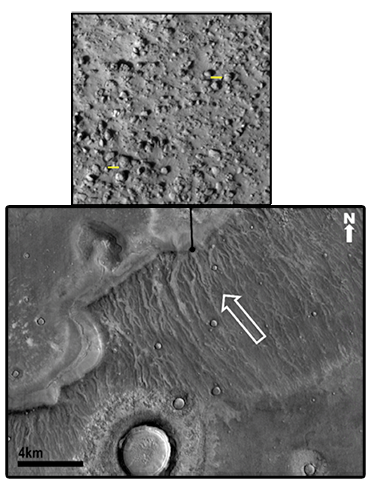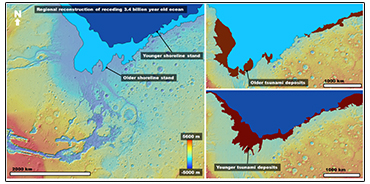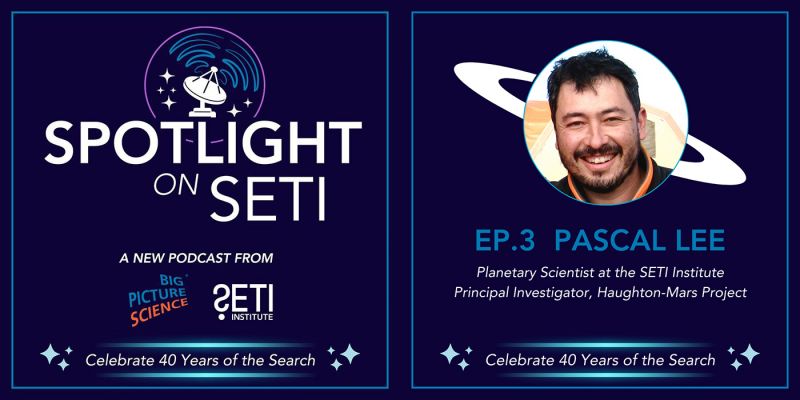Mega-tsunamis shaped Mars' surface.

Early in its geological history, Mars was thought to have experienced massive outpourings of ground water that erupted from beneath an ice-rich permafrost, carving the enormous flood channels still seen today and inundating large regions of the northern plains to form an ocean.
However, a problem with this hypothesis has been the lack of identifiable and unambiguous paleo-shoreline features.
Using geomorphic and thermal image mapping combined with numerical modeling, a recent study published in Scientific Reports shows evidence for two mega-tsunami events that happened approximately 3.4 billion years ago. These produced widespread, landward facing flow deposits and associated backwash channels extending for tens to hundreds of kilometers into the cratered highlands.
“We were surprised to find that the older and younger tsunami deposits look so different,” said lead author J. Alexis P. Rodriguez, who is a senior research scientist at the Planetary Science Institute in Tucson, Arizona. “The older tsunami washed ashore and deposited enormous volumes of debris, and evidence for the water hurtling back into the ocean is represented in widespread ‘backwash.’”
“We think that after the ocean shoreline receded to a lower elevation – which likely took place during a period of extreme climatic cooling lasting several million years – the younger tsunami occurred. Enormous waves froze as they washed over the frigid Martian landscape, before they had a chance to flow back into the ocean,” Rodriguez said.
“The tsunami deposits likely contain rocks and sediments from the ocean floor that were picked up and transported landward by these very large waves,” noted Virginia Gulick, a SETI Institute senior research scientist and a co-author on the paper. “Tsunami deposits are similar to flood deposits, except that they’re moving in the reverse (landward) direction.”
The researchers believe that, in comparison to the extremely cold and dry surface thought to have characterized Mars at the time, the ocean floor is more likely to have included habitable environments. In addition, the long amplitude and wavelength of a tsunami wave could transport marine material landward from several hundred meters in depth. Therefore, exploring tsunami deposits on Mars would allow sampling of a variety of potential ecosystems from a pre-existing ocean.
“On Earth, tsunami deposits contain a significant mud or fine-grained component. On Mars, this finer-grained component could have preserved physical or chemical evidence of past microbial activity, if it existed,” said Gulick. “If there were habitable environments, then biosignatures could have also been preserved in the large boulders visible in the older flow deposits.”
The research was conducted using visible and thermal images, combined with digital topography from Mars Odyssey, the Mars Reconnaissance Orbiter (MRO), and the Mars Global Surveyor. The research team was supported by the NASA Postdoctoral Program, NASA’s Planetary Geology and Geophysics Program, NASA’s MRO HiRISE, and the NASA Astrobiology Institute.
Figure 1: A) Backwash channels formed on the Tsunami deposits. Bouldery flow boundary shown in the enlarged image. Large white arrow shows flow direction. (Download Image)
B) Maps show reconstruction of ancient ocean shorelines and areal extent of both younger and older tsunami events. (Download Image)
Photo and map credits: J.A.P.Rodriguez.
About the SETI Institute
Founded in 1984, the SETI Institute is a non-profit, multi-disciplinary research and education organization whose mission is to lead humanity’s quest to understand the origins and prevalence of life and intelligence in the Universe and to share that knowledge with the world. Our research encompasses the physical and biological sciences and leverages expertise in data analytics, machine learning and advanced signal detection technologies. The SETI Institute is a distinguished research partner for industry, academia and government agencies, including NASA and NSF.
Contact information
Virginia Gulick
- NASA Ames Research Center, Mail Stop 239-20, Moffett Field, CA, 94035, USA
- SETI Institute, 189 Bernardo Avenue, Mountain View, CA 94043, US
- Contact Virginia Gulick
J. Alexis P. Rodriguez
- Planetary Science Institute, 1700 East Fort Lowell Road, Suite 106, Tucson, AZ 85719-2395, USA
- NASA Ames Research Center, Mail Stop 239-20, Moffett Field, CA, 94035, USA
- Contact J. Alexis P. Rodriguez







